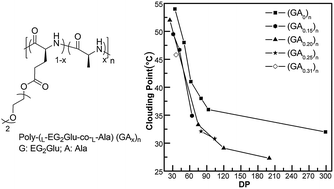Tuning the phase transition temperature of thermal-responsive OEGylated poly-l-glutamate via random copolymerization with l-alanine†
Abstract
Two series of copolymers were prepared by ring-opening polymerization (ROP) of γ-(2-methoxyethoxy)esteryl-L-glutamate (L-EG2Glu) N-carboxyanhydride (NCA) and L-alanine (L-Ala) using HMDS and PEG-NH2 as initiator, respectively. Poly-(L-EG2Glu-co-L-Ala) displayed lower critical solution temperature (LCST) behavior but had a lower phase transition temperature than poly-L-EG2Glu at similar molecular weight (MW). The clouding point (CP) of random copolypeptides can be tuned by altering the alanine content and overall MW. Circular dichroism (CD) and Fourier transform infrared spectroscopy (FTIR) indicated that the thermal-responsive properties depended on the content of ordered conformations. PEG-b-poly-(L-EG2Glu-co-L-Ala) can spontaneously form hydrogels in water at room temperature. Transmission electron microscopy (TEM) and atomic force microscopy (AFM) revealed that these hydrogels were formed by nanoribbons. The intermolecular hydrogen bonding among copolypeptide blocks accounted for the nanoribbon assemblies and hydrogel network formation.


 Please wait while we load your content...
Please wait while we load your content...